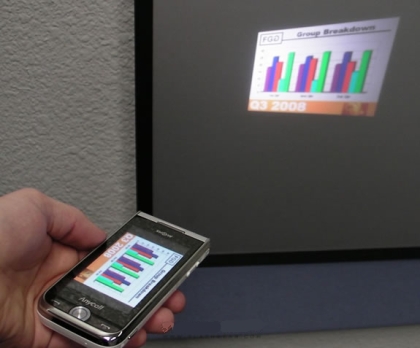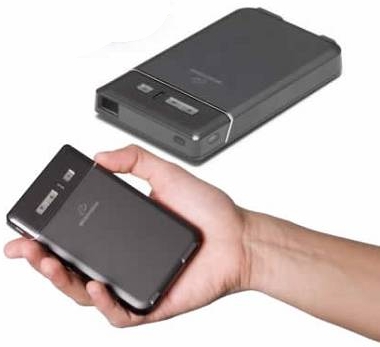Pinhole Cinema: Pico projectors take the floor
Giving an impromptu presentation or blowing up a map on your phone to an actually readable size is now a reality. Projectors are now being made small enough to fit inside cell phones, laptops, and other portable devices. These pico projectors, also called hand-held or pocket projectors, are not only small and lightweight, but also bright, powerful, and project with a high resolution image that can measure diagonally up to 250 cm or more.
The requirements for a good pico projector are steep: they need to be small, bright enough to be seen in normal lighting, project a large image size while maintaining good resolution, show good color quality and contrast, and have a battery life that will survive an entire report or movie. The first true pico projectors appeared on the market in 2008, but lacked high image quality and had no memory or battery life. This year has seen an introduction of pico projectors powerful enough to be a viable replacement for standard-size projectors.
Most pico projectors create an image either by scanning a pixel in two dimensions, imaging an array of pixels, or using a combination of imaging and scanning. The pico projector itself is a fairly simple device -- a light source, optics to direct the image, and a MEMS scanner or other processing chip -- however each company developing pico projectors is tackling the challenge from a different angle.
"There are 40- plus different ways of doing this, more than that," says James Headley, applications manager at Syndiant.

The toughest design hurdle to overcome has been to create a powerful light source that doesn't overheat electronics. "The challenge is to develop the correct microprojector configuration to balance size, cost, performance, and efficiency. These tradeoffs are primarily driven by the choices of light source and imaging mechanism," writes Vikram Bhatia, manager, New Business Development, Corning, in a recent SPIE Newsroom technical article (Green light allows big pictures from small projectors).
Most pico projectors use LEDs, with a wide combination of optics configurations. The most common is liquid crystal on silicon (LCoS), which uses liquid crystals rather than solid optics, with a single white LED. This provides a high-resolution image with a fast response time, but lacks color quality. Other pico projectors use color (RGB) LEDs with a high-powered chip, which provide better color quality but are more expensive. Digital Light Processing (DLP) technology uses several small mirrors on a semiconductor chip, with either a single or three-chip processing system, or by using three LEDs. Using these smaller mirrors creates a slightly lower resolution than LCoS. However, the three-LED projectors tend to have higher contrast, better efficiency and lower power consumption.
A few pico-projectors use lasers as their light source. The use of an exclusive laser light source was made possible by the creation of the synthetic green laser. Red and blue lasers were already in existence, so adding the green laser provided display manufacturers with the full RGB color spectrum. Corning developed the first synthetic green laser in 2006, the G-120, and a few companies have been able to demonstrate "true" green lasers in laboratory settings (see separate SPIE Newsroom article on Green Lasers).
The development of the green laser was driven by the display market, and continues to be. Corning's latest green laser, the G-2000, "was designed with exact height specifications with mobile devices in mind," says Cali Sartor, product line manager for the synthetic green laser at Corning.
A laser light source allows for higher bandwidth, higher modulation (up to 150 megahertz), and higher resolution and contrast than most LED-based pico projectors. Lasers also use less power than energy-efficient LEDs, keeping the device cooler and better able to work integrated into electronics. Laser-based projectors also create an image that is always in focus.
At the same time, speckle or noise and flicker can be issues with laser-based pico projectors. Some companies are developing anti-laser-speckle optical modules for pico projectors to address this problem. Corning, Microvision, 3M, and other companies have focused on developing better MEMS scanning micro-mirrors in their devices.

Although they haven't surpassed LEDs yet, laser-based pico projectors have the potential for higher optical power. Corning's G-2000 can produce 20 lumens at 80 milliwatts (mWatts), compared to most LED products that can only produce 15 mWatts. Syndiant's LED-based pico projector, however, has the highest reported brightness-to-watt ratio on the market so far, with 24 lumens at 4.3 watts.
Keeping the electronic system cool while producing bright, crisp images will be especially important for integration of pico projectors into smaller systems.
Most developers are trying to fit pico projectors into personal or hand-held devices, but there are limitless applications. For example, automakers are looking at pico projectors as a possibility for integrated dashboards in both commercial and consumer vehicles. The DigiLife iOne e-reader was released in early June and included a pico projector as one of its features, with a resolution of 640 x 480 pixels, about the standard for stand-alone pico projectors. MIT Media Lab, Telecommunications Research Center Vienna and others have demonstrated that pico projectors in headsets could be used as interactive devices when combined with motion tracking devices. There are also applications for biomedical purposes, defense and security, gaming and entertainment, and business.
Market research firm Yole Development predicts that the pico projector market will sell between one half and 1 million projectors this year. In-Stat is more conservative, predicting that the market revenue for pico projector modules will likely reach nearly half a billion dollars by 2014.
"Once you get a projector that small, there are so many places that these could fit," says Headley. "It's a big market, nobody knows where this is going to end up."
